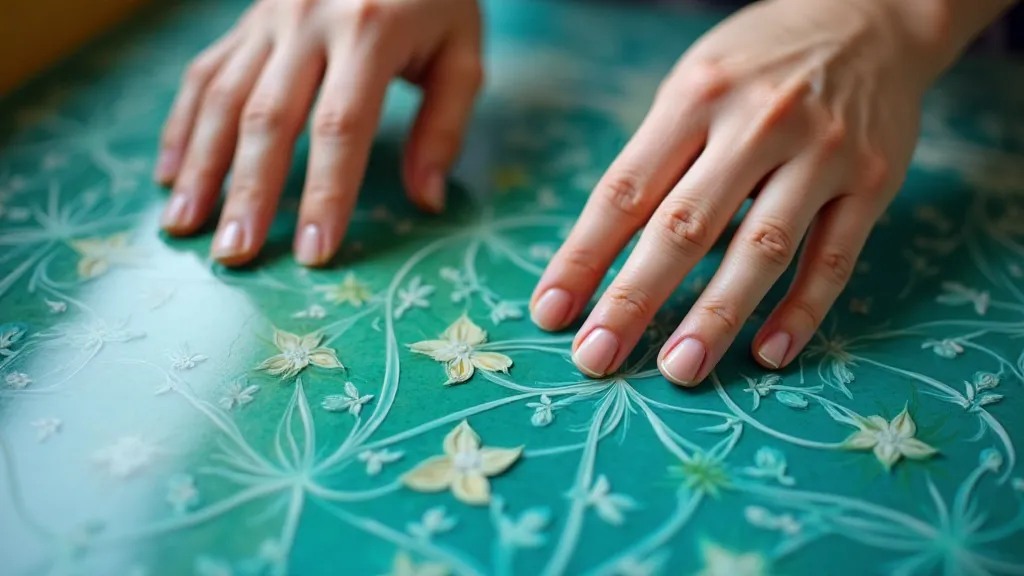The Resonance of Patterns: Finding Harmony Between Chaos and Order
There's a peculiar beauty in imperfection. In the way a weathered surface whispers stories of time and touch. I’m thinking of an antique accordion I once encountered. Its bellows, once vibrant and responsive, were now stiff, cracked, and bearing the patina of decades spent in storage. Attempting to coax a melody from it felt almost sacrilegious, yet undeniably compelling. The struggle to restore it – to coax life back into its mechanism – mirrored, in a profound way, the ancient art of paper marbling. Both endeavors require a delicate dance: embracing the unpredictable nature of chaos while simultaneously imposing a structure that allows for beauty to emerge.
Paper marbling, at its core, is an exercise in controlled serendipity. It’s the art of floating pigments on a thickened bath, manipulating them into swirling patterns, and then carefully transferring those patterns onto paper or fabric. The results are often breathtaking – a kaleidoscope of color and texture that defies replication. Each sheet is unique, a singular expression of the interplay between artist, medium, and moment.

A Historical Echo Through Time
The history of paper marbling is surprisingly complex, a tapestry woven from multiple cultural threads. While its origins are debated, evidence suggests that forms of surface decoration utilizing floating pigments existed in ancient Egypt and Persia. However, the technique as we recognize it today largely evolved in 16th and 17th century Europe, particularly in Italy and Turkey. In Italy, it was known as Carta Marmorata, referencing the resemblance of the marbled patterns to marble. The Ottomans, meanwhile, referred to it as Ebru.
The Ottoman tradition of Ebru is especially compelling. It wasn’t simply a decorative technique; it was imbued with spiritual significance. The swirling patterns were seen as reflections of the divine, fleeting moments of beauty that revealed glimpses of the cosmos. Skilled Ebru masters were highly revered, and their creations were often used to adorn Qur’ans and other sacred texts. The act of creating Ebru was almost meditative, a way to connect with the infinite.
The popularity of paper marbling waxed and waned throughout the centuries. It experienced a resurgence in the Victorian era, where it was used to create decorative papers for bookbinding and other crafts. However, it gradually fell into obscurity, largely forgotten until its rediscovery by modern artists and craft enthusiasts in recent decades.
The Alchemy of Pigments and Bath
So, what exactly *is* the process? It begins with the bath – a viscous mixture of seaweed extract (often carrageenan or guar gum), water, and a surfactant. This thickened solution provides the platform upon which the pigments will float. Then come the pigments themselves, typically vibrant powdered colors derived from natural sources – minerals, plants, and even insects. These pigments are carefully dispersed in a liquid medium, often a mixture of alcohol and surfactant, to reduce their surface tension.
The real magic happens when the pigmented solutions are gently dripped onto the bath. The droplets spread, creating expanding circles of color. Using specialized tools – rakes, combs, brushes, even simple sticks – the artist manipulates the pigments, drawing them into swirling patterns. The possibilities are endless; each movement, each addition of color, alters the composition in unpredictable ways. This is where the ‘chaos’ element comes into play – the unpredictable nature of the floating pigments means that the final result is never entirely predictable.

Structure within the Flow
While the process embraces chaos, it's crucial to understand that it's a *controlled* chaos. A successful marbler isn’s simply reacting to what unfolds. They’re actively shaping it, guiding it, responding to its nuances. They understand the properties of the bath, the behavior of the pigments, and the principles of composition. They know when to add more color, when to rake, and when to leave the pattern alone.
This mirrors the art of writing, particularly creative writing. A compelling narrative often emerges from a messy first draft, a swirling mass of ideas and observations. It’s in the subsequent revisions, the careful crafting of sentences and paragraphs, that the story finds its form. The initial chaos of inspiration is tamed, structured, and polished until it resonates with clarity and meaning. Both the marbler and the writer are engaging in a delicate dance between freedom and constraint. They are allowing themselves to be guided by intuition while simultaneously imposing a structure that allows their vision to materialize.
Collecting and Restoration: A Labor of Love
For those drawn to the beauty of paper marbling, there are two compelling avenues to explore: collecting antique marbled papers and, for the more adventurous, attempting restoration. Antique marbled papers offer a fascinating glimpse into the history of the craft, showcasing the evolving styles and techniques of past artisans. The papers themselves often bear the marks of time – foxing, fading, and the subtle imperfections that attest to their age.
Restoration, however, is a significantly more complex undertaking. It requires a deep understanding of the materials and techniques involved, as well as a delicate touch. Attempting to repair damaged marbled papers without proper knowledge can easily cause further harm. Just as with the antique accordion – a hasty, unskilled restoration can render it practically worthless. It's often preferable to preserve the paper’s existing condition, appreciating its history and imperfections rather than attempting to erase them.
The restoration process might involve carefully cleaning the paper to remove surface dirt and grime, mending tears with archival-quality materials, and, in some cases, attempting to recreate lost areas of the marbled pattern. However, this is a challenging and time-consuming endeavor, best left to experienced conservators.

Embracing the Impermanence
Ultimately, the allure of paper marbling lies in its embrace of impermanence. Each sheet is unique, a fleeting moment captured in color and texture. This quality resonates deeply, reminding us of the beauty that exists in the ephemeral, the transient. It’s a quiet lesson in letting go, in appreciating the present moment, and in finding harmony between the forces of chaos and order. Like the faint, beautiful melody coaxed from a restored antique accordion, the art of paper marbling offers a glimpse into a world where imperfection is not a flaw, but a source of extraordinary beauty.





